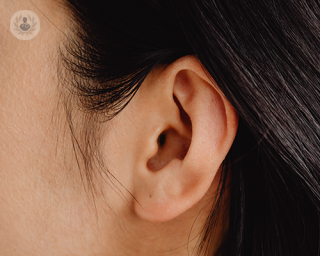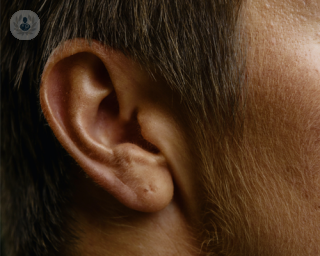What is a cholesteatoma?
A cholesteatoma is a rare abnormal growth of skin in the middle ear behind the eardrum that is formed of skin cells. Over time it can grow and destroy middle ear bones or nearby ear structures.

If left untreated, a cholesteatoma can lead to further complications, including ear infections, hearing loss, tinnitus (sounds which come from inside the body rather than external noise), and vertigo (dizziness or the sensation things are spinning). A cholesteatoma can also cause damage to the facial nerve.
Are cholesteatoma serious?
A cholesteatoma can, on very rare occasions, spread to the brain and inner ear, which can lead to meningitis, or a brain abscess. However, it is important to note that this is exceedingly rare.
What are the symptoms of a cholesteatoma?
A cholesteatoma generally only affects one ear, and some common symptoms include:
- Hearing loss (which is usually gradual)
- Loss of balance/dizziness
- A watery discharge from the ear, which can smell bad
- Discomfort in the affected ear
Some of the symptoms are similar to those of an ear infection, so it is best to visit your GP who can check the symptoms and refer to a specialist if necessary.
What causes cholesteatoma?
Congenital cholesteatomas are rare, but they can occur. Cholesteatomas can also form if part of the eardrum collapses, which creates a ‘pocket’ in the ear where dead skin cells collect. This can also occur if the eardrum is damaged in any way, such as during surgery, or after an injury or infection.
How is cholesteatoma treated?
A cholesteatoma generally has to be removed through surgery, which is usually successful. However, in some cases, the cholesteatoma may reappear, meaning further surgery may be needed.
There are rarely complications following cholesteatoma surgery, but your surgeon will explain the risks the procedure carries beforehand.
01-19-2016 09-18-2023Cholesteatoma
Mr Ibrahim Albert Srouji - Otolaryngology / ENT
Created on: 01-19-2016
Updated on: 09-18-2023
Edited by: Karolyn Judge
What is a cholesteatoma?
A cholesteatoma is a rare abnormal growth of skin in the middle ear behind the eardrum that is formed of skin cells. Over time it can grow and destroy middle ear bones or nearby ear structures.

If left untreated, a cholesteatoma can lead to further complications, including ear infections, hearing loss, tinnitus (sounds which come from inside the body rather than external noise), and vertigo (dizziness or the sensation things are spinning). A cholesteatoma can also cause damage to the facial nerve.
Are cholesteatoma serious?
A cholesteatoma can, on very rare occasions, spread to the brain and inner ear, which can lead to meningitis, or a brain abscess. However, it is important to note that this is exceedingly rare.
What are the symptoms of a cholesteatoma?
A cholesteatoma generally only affects one ear, and some common symptoms include:
- Hearing loss (which is usually gradual)
- Loss of balance/dizziness
- A watery discharge from the ear, which can smell bad
- Discomfort in the affected ear
Some of the symptoms are similar to those of an ear infection, so it is best to visit your GP who can check the symptoms and refer to a specialist if necessary.
What causes cholesteatoma?
Congenital cholesteatomas are rare, but they can occur. Cholesteatomas can also form if part of the eardrum collapses, which creates a ‘pocket’ in the ear where dead skin cells collect. This can also occur if the eardrum is damaged in any way, such as during surgery, or after an injury or infection.
How is cholesteatoma treated?
A cholesteatoma generally has to be removed through surgery, which is usually successful. However, in some cases, the cholesteatoma may reappear, meaning further surgery may be needed.
There are rarely complications following cholesteatoma surgery, but your surgeon will explain the risks the procedure carries beforehand.


Cholesteatoma: is it dangerous?
By Mr Michael Pringle
2024-12-26
There are many things that can affect our ears and our hearing, but some are potentially more damaging than others. Cholesteatoma is a type of cyst, which, while not cancerous, has the potential to cause serious health problems. Leading ENT surgeon Mr Michael Pringle is here to explain. See more


Outer and middle ear infections: An expert insight
By Professor Mahmood Bhutta
2024-12-24
Ear infections are a very common illness, particularly in children, that can cause earache and discomfort. Here, Professor Mahmood Bhutta, renowned consultant ENT surgeon, provides an expert insight into ear infections, including causes and treatment. See more


A specialist explains: cholesteatoma essentials
By Professor Mahmood Bhutta
2024-12-20
Though one of the smallest parts of the body, the eardrum and bones in the ear are important for our hearing ability. There are a multitude of conditions that can impact this ability, one being a cholesteatoma. In this article, expert consultant ENT surgeon Professor Mahmood Bhutta clarifies what it is and why it is important to have it taken care of. See more


Have you heard about cholesteatomas?
By Mr Nish Mehta
2024-12-19
Cholesteatomas, rare but potentially dangerous cysts that grow deep in the ear canal and can interfere with other vital structures. What causes them, how are they diagnosed, and most importanlty how are they treated? Leading consultant ENT surgeon Mr Nish Mehta shares his expertise on the condition. See more
Experts in Cholesteatoma
-
Mr Abhijeet Parikh
Otolaryngology / ENTExpert in:
- Hearing loss
- Otosclerosis
- Cholesteatoma
- Rhinitis
- Nasal polyps
- Voice disorders
-
Professor Shakeel Saeed
Otolaryngology / ENTExpert in:
- Cochlear Implants
- Endoscopic skull base surgery
- Hearing loss
- Tinnitus
- Cholesteatoma
- Otosclerosis
-
Mr Michael Pringle
Otolaryngology / ENTExpert in:
- Middle ear surgery
- Deafness
- Tinnitus
- Cholesteatoma
- Paediatric ENT
- Tonsillitis
-
Mr Harry Powell
Otolaryngology / ENTExpert in:
- Cholesteatoma
- Cochlear Implants
- Ear infection
- Tonsillectomy
- Hearing loss
- Otosclerosis
-
Mr Nish Mehta
Otolaryngology / ENTExpert in:
- Otology
- Cochlear Implants
- Hearing loss
- Cholesteatoma
- Ear infection
- Paediatric ENT
- See all

OneWelbeck Ear Nose & Throat
OneWelbeck Ear Nose & Throat
1 Welbeck St, London, W1G 0AR
No existe teléfono en el centro.
By using the telephone number provided by TOP DOCTORS, you automatically agree to let us use your phone number for statistical and commercial purposes. For further information, read our Privacy Policy
Top Doctors

The Lister Hospital - part of HCA Healthcare
The Lister Hospital - part of HCA Healthcare
Chelsea Bridge Road, London
No existe teléfono en el centro.
By using the telephone number provided by TOP DOCTORS, you automatically agree to let us use your phone number for statistical and commercial purposes. For further information, read our Privacy Policy
Top Doctors

London Bridge Hospital - part of HCA Healthcare
London Bridge Hospital - part of HCA Healthcare
27 Tooley St
No existe teléfono en el centro.
By using the telephone number provided by TOP DOCTORS, you automatically agree to let us use your phone number for statistical and commercial purposes. For further information, read our Privacy Policy
Top Doctors
-
OneWelbeck Ear Nose & Throat
1 Welbeck St, London, W1G 0AR, W1G Marylebone LondonExpert in:
- Voice disorders
- Sleep apnoea
- Audiology
- Blocked nose
- endoscopy
- Otolaryngology
-
The Lister Hospital - part of HCA Healthcare
Chelsea Bridge Road, London , Central LondonExpert in:
- Cancer
- Cardiology
- Orthopaedic surgery
- Pregnancy
- Physiotherapy
- Women’s health
-
London Bridge Hospital - part of HCA Healthcare
27 Tooley St, Central LondonExpert in:
- 24-hour service
- Cardiology
- Minimal access surgery (keyhole surgery)
- Orthopaedic surgery
- Cardiovascular disease
- Gastroenterology
- See all
- Most viewed diseases, medical tests, and treatments
- Snoring
- Polysomnography (sleep study)
- Nystagmus
- Migraine
- Minimal access surgery (keyhole surgery)
- Head and neck cancer
- Neck lump
- Botulinum toxin (Botox™)
- Thyroid disorders
- Anti-ageing treatments








